Family

 My great grandniece, Alice Green is growing ups so fast. It shocks me sometimes. When school starts this year, she will be in middle school as a 6th grader. That is the beginning of a whole new world. The reality is that she isn’t a little girl anymore. She middle school is when girls start getting into boys, makeup, and their appearance in general. A girl has to look good no matter who she is hanging out with at the time. Alice is no exception. Her personality is changing, and she is thinking about more grownup things. Baby dolls and toys are a thing of the past now, unless she is playing with her younger
My great grandniece, Alice Green is growing ups so fast. It shocks me sometimes. When school starts this year, she will be in middle school as a 6th grader. That is the beginning of a whole new world. The reality is that she isn’t a little girl anymore. She middle school is when girls start getting into boys, makeup, and their appearance in general. A girl has to look good no matter who she is hanging out with at the time. Alice is no exception. Her personality is changing, and she is thinking about more grownup things. Baby dolls and toys are a thing of the past now, unless she is playing with her younger  siblings, Izabella and Jaxx Harman. Then, she makes an exception an reverts to her little girl ways for just a little while.
siblings, Izabella and Jaxx Harman. Then, she makes an exception an reverts to her little girl ways for just a little while.
Alice loves her siblings very much, and her sister, Izabella “Belle” is one of her best friends. They have been since Belle was born. Alice had been an only child for the first three years of her life, and Alice had been wanting a sibling for a while. Other kids she knew had siblings, and she wanted some too. Then, suddenly, she had one…and then two. She felt very blessed. Of course, Alice and her siblings fight sometimes, like all siblings do. Nevertheless, they still love each other very much.
Alice has such a great sense of humor and is so ornery sometimes just like her dad, Jake Harman. Jake came into her life when she was about 2 years old, but he has definitely rubbed off on her. Jake is a funny character, who loves to laugh. Alice and her 
 dad are hilarious together, and they keep the whole family in stitches. In many other ways, Alice is like her mom though. In fact, she is her mom, Melanie Harman’s “little mini me” as well. Like her mom, she is a little bit clumsy and loves music, and then there are her looks, so much like her mom. Her parents can’t believe how much she has grown and changed over the years. Before they know it, she will be a teenager, and then all bets are off, but that is a couple of years yet. Today is Alice’s 11th birthday. Happy birthday Alice!! Have a great day!! We love you!!
dad are hilarious together, and they keep the whole family in stitches. In many other ways, Alice is like her mom though. In fact, she is her mom, Melanie Harman’s “little mini me” as well. Like her mom, she is a little bit clumsy and loves music, and then there are her looks, so much like her mom. Her parents can’t believe how much she has grown and changed over the years. Before they know it, she will be a teenager, and then all bets are off, but that is a couple of years yet. Today is Alice’s 11th birthday. Happy birthday Alice!! Have a great day!! We love you!!

 My niece, Chantel Balcerzak says of her husband Dave Balcerzak, “Life isn’t necessarily exciting, but maybe that in itself is pretty exciting. I read once that contentment started in your 50s. At the time, about 20 years ago, I thought if it was true then it was rude!! Nevertheless, it is true. Dave and I are content, occasionally blissful, and far more confident than I ever imagined. He’s a genius, he diets until he’s done or not! Either way he’s a total stud!! He works on his car or plays video games, and we take walks. We are content…nowhere near finished…content.” What a beautiful sentiment. I think lots of us in our “beyond 50s years” feel the same way, but we have never really put it into words, and certainly never quite so eloquently.
My niece, Chantel Balcerzak says of her husband Dave Balcerzak, “Life isn’t necessarily exciting, but maybe that in itself is pretty exciting. I read once that contentment started in your 50s. At the time, about 20 years ago, I thought if it was true then it was rude!! Nevertheless, it is true. Dave and I are content, occasionally blissful, and far more confident than I ever imagined. He’s a genius, he diets until he’s done or not! Either way he’s a total stud!! He works on his car or plays video games, and we take walks. We are content…nowhere near finished…content.” What a beautiful sentiment. I think lots of us in our “beyond 50s years” feel the same way, but we have never really put it into words, and certainly never quite so eloquently.
Dave has been such a good role model for his kid and bonus kids, who never consider him their stepdad. He is just “Dad” to them, and he was there when he didn’t have to be, but he chose to be. My grandniece, Siara Kirk (his bonus daughter) tells me that if Dave has to be up early, before Chantel gets up, “He also leaves the cutest  notes for my mom in the morning, when he wakes up and leaves before she wakes up.” It’s an endearing thing for Siara to see her mom so loved. And it’s such a beautiful thing for Chantel to wake up to.
notes for my mom in the morning, when he wakes up and leaves before she wakes up.” It’s an endearing thing for Siara to see her mom so loved. And it’s such a beautiful thing for Chantel to wake up to.
Dave, Chris Kirk (Siara’s husband), and her brother, Jake Harman (Dave’s bonus son) all three-way call each other to play video games. It’s one of the ways they stay connected in a busy world. Dave is always so welcoming to everyone and so kind. Siara has multiple customers, at the banks where she works, who Dave helps to fix their computers…always for a good price, and they adore him. I can totally relate to that, because he is my computer guy too…and in fact really bailed me out when he managed to rescue all of my many photographs after my hard drive totally crashed. The photographs were irreplaceable. Needless to say, I cried when he saved them!!
Dave also helps all the older people in the neighborhood when they need help!! That is so sweet, because as we all know, it’s hard for the elderly population to get some of the things done that they need done around their houses every day. And while it can be a bit comical, such as the lady across the street who always puts the batteries in her television remote backwards, Dave never laughs at her. He just goes over and fixes the remote for her. Dave is always very supportive of Chantel’s endeavors. Chantel loves to paint. She is a great artist, and even like painting houses, which could become a new career. Currently she is planning to paint Siara and Chris’ home, and so in true Dave style, he surprised Chantel with a “fancy paint gun” so she would have what she needed to succeed. Siara says, “He is always so encouraging and believes in his loved ones more than they do at times.” Dave also loves to go on trips with Siara, Chris, and Chantel. They have such a great time. They have attended football games at the University of Wyoming, as well as, attending the “Hairball” concert. They all had a great time.


When it comes to his dogs, all bets are off. Dave is a “sucker” for those puppy faces. They can usually get away with just about anything…unless Chantel steps in to “make them” behave. Nevertheless, the dogs know that if they “smile” for “Daddy” they will get a treat, and Dave can never refuse. He is just too soft hearted, and the pups know it, but Dave isn’t the only one to ever find himself in that position. A dog lover is a dog lover, and those pups know it. Today is Dave’s birthday. Happy birthday Dave!! Have a great day!! We love you!!
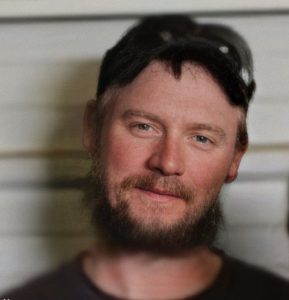
 My nephew, JD Parmely is a basic workaholic, just like his uncles and his brothers. He works all day as a mechanic for Ken’s Auto Repair, and then goes home, eats dinner, and spends the next few hours working on cars in his garage. In fact, sometimes he might work into the “wee hours” of the morning, if he needs to get something done. Of course, that means he will most likely sleep in the next morning, so don’t look for him too early after an all nighter. Mechanic work is the only work JD ever wanted to do, and he went to school for it in Phoenix, Arizona…in what he said was the hottest place ever, and he couldn’t wait to leave. Still, it was a good school for him, and he got what he needed to land a good job in his career of choice.
My nephew, JD Parmely is a basic workaholic, just like his uncles and his brothers. He works all day as a mechanic for Ken’s Auto Repair, and then goes home, eats dinner, and spends the next few hours working on cars in his garage. In fact, sometimes he might work into the “wee hours” of the morning, if he needs to get something done. Of course, that means he will most likely sleep in the next morning, so don’t look for him too early after an all nighter. Mechanic work is the only work JD ever wanted to do, and he went to school for it in Phoenix, Arizona…in what he said was the hottest place ever, and he couldn’t wait to leave. Still, it was a good school for him, and he got what he needed to land a good job in his career of choice.
JD is also a caraholic, and I don’t mean it the sense that he works on cars, but rather that he loves to “own” cars. He must have a dozen of them, all insured, and he is the only driver. Some people might think JD is crazy, but I say, “It’s up to him.” He loves his cars, and there is no law against the cars he has. JD drives all of his cars at different times, because, as any mechanic knows, you have to drive your car periodically to keep everything lubricated and in good working order.
While JD enjoys working on his own cars, he has a heart for other people, and is always there to help others with their car problems. And sometimes the help he gives has nothing to do with cars, but rather farm 
 equipment on his brother, Eric Parmely’s farm. JD loves going out to Eric and his wife, Ashley’s farm, if for no other reason, to see his nieces, Reagan, Hattie, and Maeve Parmely, and nephew, Bowen. JD loves kids, and even babysits once in a while. JD is like a big kid, really. Kids relate to him, because he is really a big kid himself. He still remembers how to have fun, and what it’s like to be a kid. Nevertheless, JD is a hardworking man, who feels a sense of responsibility toward his fellowman. That’s why he is always so willing to help people out. Today is JD’s birthday. Happy birthday JD!! Have a great day!! We love you!!
equipment on his brother, Eric Parmely’s farm. JD loves going out to Eric and his wife, Ashley’s farm, if for no other reason, to see his nieces, Reagan, Hattie, and Maeve Parmely, and nephew, Bowen. JD loves kids, and even babysits once in a while. JD is like a big kid, really. Kids relate to him, because he is really a big kid himself. He still remembers how to have fun, and what it’s like to be a kid. Nevertheless, JD is a hardworking man, who feels a sense of responsibility toward his fellowman. That’s why he is always so willing to help people out. Today is JD’s birthday. Happy birthday JD!! Have a great day!! We love you!!
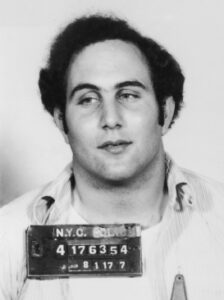 Mental illness can cause people to do insane things. On August 10, 1977, a 24-year-old postal employee named David Berkowitz was arrested and charged with being the “Son of Sam” serial killer who terrorized New York City for more than a year. He killed six young people and wounded seven others with a .44-caliber revolver. Serial killers have a specific type of target victim, and Berkowitz generally targeted attractive young women with long brown hair. The women in New York City were so frightened that hundreds of young women had their hair cut short and dyed blonde during the time “Son of Sam” terrorized the city. Thousands more women were too scared to even leave their homes at night.
Mental illness can cause people to do insane things. On August 10, 1977, a 24-year-old postal employee named David Berkowitz was arrested and charged with being the “Son of Sam” serial killer who terrorized New York City for more than a year. He killed six young people and wounded seven others with a .44-caliber revolver. Serial killers have a specific type of target victim, and Berkowitz generally targeted attractive young women with long brown hair. The women in New York City were so frightened that hundreds of young women had their hair cut short and dyed blonde during the time “Son of Sam” terrorized the city. Thousands more women were too scared to even leave their homes at night.
August 10th finally brought his reign of terror to an end. After his arrest, Berkowitz claimed that demons and a black Labrador retriever owned by a neighbor named Sam had ordered him to commit the killings. These statements were the first signs that Berkowitz was a Paranoid Schizophrenic…a condition he was later diagnosed with. Mental illness is not an excuse for murder, but I suppose it is an explanation of sorts. David Berkowitz was born Richard David Falco on June 1, 1953, in Brooklyn, New York. His biological mother, Elizabeth “Betty” Broder, placed him for adoption within a few days. His biological father, Joseph Klineman was a married man with whom Broder had a three-year affair. ? The exact reason for Broder’s decision is unknown, but it has been speculated that Klineman threatened to leave her if she kept the baby and if she used his name. Although her reasons for giving Richard away are unknown, have surmised that Klineman threatened to abandon her if she kept the baby and used his name. Broder had grown up as part of an impoverished Jewish family and was working as a waitress. Prior to meeting Klineman, in 1936. She married Tony Falco, an Italian American, who left her for another woman less than four years later. David Berkowitz was adopted by Pearl and Nathan Berkowitz. David loved his adoptive parents and did well until he was traumatized by the death of his adoptive mother from cancer in 1967. That event caused him to become a recluse. In 1971, Berkowitz joined the army and served for three years. He seemed to be in his element and distinguished himself as a talented marksman. In 1974, he returned to New York and worked as a security guard, but his mental condition began to severely deteriorate in 1975. Still a recluse, he began to feel very isolated from the world around him, and he set hundreds of arson fires in New York without being caught.
It was at this time that he began to hear voices of, in his own words, “demons” that tormented him and told him to commit murder. His first attempt came on Christmas Eve, 1975, when is gave into the “demons” and severely wounded 15-year-old Michelle Forman with a hunting knife. In January 1976, after moving into a two-family home in Yonkers, Berkowitz became convinced that the German shepherd that lived in the house and other neighborhood dogs were possessed by demons who ordered him to murder attractive young women. It seems so strange that he connected dogs with the voices his disease caused him to hear. Then his condition progressed, and he also started seeing his neighbors as demons. In April, Berkowitz moved to an apartment house in Yonkers, but this new home also had dogs. His neighbor, retiree Sam Carr, had a black Labrador retriever named Harvey, who Berkowitz believed pleaded with him to kill. He also saw Sam Carr as a powerful demon and was referring to him when he began calling himself “Son of Sam.” On July 28, 1976, Berkowitz quit his job as a security guard, and the killing spree began. Over the next year, Berkowitz killed 6 women. He wounded 11 more, two of which were actually stabbed in 1975. His fatal victims were Donna Lauria, Christine Freund, Virginia Voskerichian, Valentina Suriani, Alexander Esau (Esau was only killed because he was in the way as he kissed Valentina Suriani), and Stacy Moskowitz who was also kissing her boyfriend. Bobby Violante, lost his left eye and nearly all the vision in his right eye, but he lived.
Finally getting a ballistics match after the killing of Virginia Voskerichian, it was determined that this was a serial killer. The New York police announced that a serial killer was on the loose, known to be a white male in his 20s, with black hair and of average height and build. A task force was assembled, called “The Omega Task Force.” Berkowitz was getting brave, now leaving a note with his victims identifying himself as “Son of Sam.” Then, on April 29, Berkowitz shot Sam Carr’s Labrador retriever. He had previously sent an anonymous, threatening letter to Mr Carr concerning the animal. The dog recovered, and the Yonkers police began an investigation. Then, Berkowitz started sending insane letters to other neighbors and his former landlords. These people began to suspect Berkowitz and called the police. individuals began to suspect Berkowitz to be the Son of Sam and reported their suspicions to local police. Still, the detectives of The Omega Task Force, even after receiving thousands of reports of Son of Sam “suspects” and were nevertheless having a difficult time sifting through all the dead-end leads.
On June 26, the Son of Sam struck again, wounding Judy Placido and Sal Lupo as they sat in their car after leaving a Queens disco. A few days later, a major break in the case came when an eyewitness came forward to report that she had seen a man with what looked like a gun minutes before the shots were fired in Brooklyn. Her information led to the first police sketch of Berkowitz. More important, she reminded investigators that two police officers had been writing parking tickets on her street that night. A search of tickets issued eventually turned up Berkowitz’s car. At the same time, Yonkers police investigated Berkowitz after he escalated a harassment campaign against one of his neighbors. Convinced he was the “Son of Sam” they informed the Omega task force of their findings. The Omega detectives finally put two and two together, and on August 10 David Berkowitz was arrested while leaving his Yonkers home. He excitedly admitted to being the “Son of Sam.” It was like it had all been a game of “hide and seek” in his mind. At the time, he had his semiautomatic rifle. He told them that he was on his way to commit another murder. The .44-caliber revolver was also recovered. 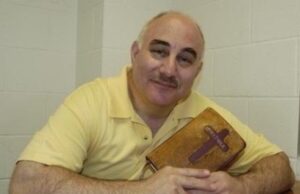 There was some question about whether Berkowitz was mentally fit to stand trial, but on May 8, 1978, he changed his insanity plea to guilty on six counts of murder. The whole time, he seemed to enjoy the publicity. The case prompted New York state to adopt the first in a nationwide series of so-called “Son of Sam laws” that take proceeds a criminal earns from selling their story and gives them to a victims’ compensation fund.
There was some question about whether Berkowitz was mentally fit to stand trial, but on May 8, 1978, he changed his insanity plea to guilty on six counts of murder. The whole time, he seemed to enjoy the publicity. The case prompted New York state to adopt the first in a nationwide series of so-called “Son of Sam laws” that take proceeds a criminal earns from selling their story and gives them to a victims’ compensation fund.
Berkowitz was given six 25-years-to-life sentences for the crime, the maximum penalty allowed at the time. He has since been denied parole. He is currently held at the Shawangunk Correctional Facility in upstate New York, where he allegedly converted to Christianity. I pray that is so.

 My grandniece, Katie Balcerzak has been a part of this family for a very long time. When she was dating my grandnephew, Keifer Balcerzak, I remember thinking a couple of things. The first was that she was a beautiful girl, and the second was that she and Keifer seemed so young. You don’t often see high school sweethearts who get married, and then stay married, but these kids did, and they are very happy. Their marriage has been blessed with two beautiful children, Reese and Asa, who share their sweet mommy’s smile. These beautiful babies are the everything to their parents, and the four of them are happy as can be.
My grandniece, Katie Balcerzak has been a part of this family for a very long time. When she was dating my grandnephew, Keifer Balcerzak, I remember thinking a couple of things. The first was that she was a beautiful girl, and the second was that she and Keifer seemed so young. You don’t often see high school sweethearts who get married, and then stay married, but these kids did, and they are very happy. Their marriage has been blessed with two beautiful children, Reese and Asa, who share their sweet mommy’s smile. These beautiful babies are the everything to their parents, and the four of them are happy as can be.
Katie is such a loving mom, and her babies are everything to her…and Keifer too, of course. He is Katie’s best friend. They are totally compatible and are always going in the same direction in life. They are best friends, and I think they 
 were best friends long before they married, but then that’s pretty common in “best friend” marriages. Now their friendship has grown and includes their children. Katie is teaching her kids to love life. They play. They laugh. They smile…and those smiles light up every one of those faces. In fact, their whole face smiles.
were best friends long before they married, but then that’s pretty common in “best friend” marriages. Now their friendship has grown and includes their children. Katie is teaching her kids to love life. They play. They laugh. They smile…and those smiles light up every one of those faces. In fact, their whole face smiles.
This has been a very full summer for the whole Balcerzak family. Everyone has been to or participated in sporting events. Katie is a “sports mom” who goes to almost everything her kids participate in. And the stuff 
 her husband participates in. Reece has tried a number of sports, from t-ball to horseback riding, and Katie has supported her in each new endeavor. That’s the thing about Katie. She is one of the greatest support persons out there. If you look at Katie’s Facebook page, you will find very few pictures of her, because it’s all about her family. She is so supportive of anything they like. This summer, Reece is into gardening, so the pictures show Reece and her flowers. Asa is into just about anything his big sister in into, although the flowers aren’t his big interest…the sprinkler is, hahaha!! It doesn’t matter. Katie is just enjoying the whole process of watching her kids grow up. Today is Katie’s birthday. Happy birthday Katie!! Have a great day!! We love you!!
her husband participates in. Reece has tried a number of sports, from t-ball to horseback riding, and Katie has supported her in each new endeavor. That’s the thing about Katie. She is one of the greatest support persons out there. If you look at Katie’s Facebook page, you will find very few pictures of her, because it’s all about her family. She is so supportive of anything they like. This summer, Reece is into gardening, so the pictures show Reece and her flowers. Asa is into just about anything his big sister in into, although the flowers aren’t his big interest…the sprinkler is, hahaha!! It doesn’t matter. Katie is just enjoying the whole process of watching her kids grow up. Today is Katie’s birthday. Happy birthday Katie!! Have a great day!! We love you!!
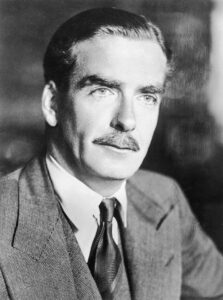 Out of necessity, comes innovation. Many of history’s great problems were solved because it was a necessity. For the most part, Britain has maintained a small British Army. Somehow, probably mostly due to geography, rather than might, the British Royal Navy was able to protect the island nation from its enemies quite well…until World War I, that is, and indeed, young men did not feel the need to join the army due to patriotic duty, but rather due to a shortage of other working options. In fact, a career in the military wasn’t looked upon favorably at all.
Out of necessity, comes innovation. Many of history’s great problems were solved because it was a necessity. For the most part, Britain has maintained a small British Army. Somehow, probably mostly due to geography, rather than might, the British Royal Navy was able to protect the island nation from its enemies quite well…until World War I, that is, and indeed, young men did not feel the need to join the army due to patriotic duty, but rather due to a shortage of other working options. In fact, a career in the military wasn’t looked upon favorably at all.
When World War I broke out in 1914, Britain suddenly experienced a huge shortage of trained military personnel, especially officers. This was further complicated by heavy casualties in the British Expeditionary Force in France, which dwindled the limited supply even further. That meant to keep up, they were going to need a large number of officers to be sourced and trained quickly. Their only real solution was to take young upper-class men and put them through officer training. These were teenagers, young men still in school, but it was necessary, and so schooling was either ended or postponed.
During World War I, as was seen with the RMS Titanic, class was considered of the utmost importance. In Britain, only a gentleman could be an officer. The working-class and lower-class men were put in as the average 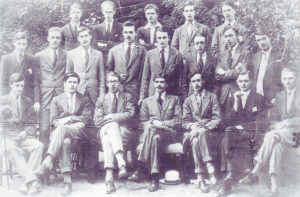 soldier. Somehow it was thought that “Short of actual military credentials, a person’s schooling was thought to be a reasonable litmus test for leadership.” To further confuse things in the minds of most Americans these days, a public school in Britain is actually a very exclusive private institution. Eton College, a private institution attended by no fewer than 20 prime ministers, is probably the best example of that. Anthony Eden, who would later become prime minister, was an Eton alum, who also served as an officer in the British Army.
soldier. Somehow it was thought that “Short of actual military credentials, a person’s schooling was thought to be a reasonable litmus test for leadership.” To further confuse things in the minds of most Americans these days, a public school in Britain is actually a very exclusive private institution. Eton College, a private institution attended by no fewer than 20 prime ministers, is probably the best example of that. Anthony Eden, who would later become prime minister, was an Eton alum, who also served as an officer in the British Army.
When World War I broke out, Eden was just 17, and after a rushed officer training course, he was commissioned as a second lieutenant a year later. It seems strange and almost reckless to have upper-class teenagers leading working-class soldiers, but in this case, it actually worked well. The teenage future prime minister recalled his men “were tolerant of me as we were all learning together.” Eden quickly learned that “As long as the officer showed proper concern for the well-being of his men and courage under fire, the men in turn would show great loyalty.”
The commissioned officers were also helped enormously by the noncommissioned officers. The  noncommissioned officers were usually working-class men who had been promoted from the ranks after showing leadership abilities throughout their military careers. Thankfully so, because as Eden would later recall of a sergeant named Arnold Rushworth in his post-war memoirs, “He was my right hand and no small part of my brain as well.” I’m sure that part of the reason this plan of upper-class men becoming officers worked was the sheer compassion of the working-class men, who helped them along the way. It was the way of the times, and I suppose that the men simply accepted their “position” in life as being the way things were, and that it could not be changed.
noncommissioned officers were usually working-class men who had been promoted from the ranks after showing leadership abilities throughout their military careers. Thankfully so, because as Eden would later recall of a sergeant named Arnold Rushworth in his post-war memoirs, “He was my right hand and no small part of my brain as well.” I’m sure that part of the reason this plan of upper-class men becoming officers worked was the sheer compassion of the working-class men, who helped them along the way. It was the way of the times, and I suppose that the men simply accepted their “position” in life as being the way things were, and that it could not be changed.

 My nephew Jake Harman is one husband who is madly in love with his wife. He never has anything but wonderful things to say about his wife, Melanie “Mel” Harman. So often, Jakes words concerning his wife are so much better than anything I could write, that I find myself just putting his words down, and making little additions here and there. Jake tells me that, “Mel is the best wife in the world and an even better mother. We have been together eight years and her laugh gets better every time I hear it, and her smile more beautiful than the last time I saw it. I have had the honor of spending her last 8 birthdays with her and being able to call her mine which makes me the luckiest man alive.” The love Jake feels for Mel is immeasurable.
My nephew Jake Harman is one husband who is madly in love with his wife. He never has anything but wonderful things to say about his wife, Melanie “Mel” Harman. So often, Jakes words concerning his wife are so much better than anything I could write, that I find myself just putting his words down, and making little additions here and there. Jake tells me that, “Mel is the best wife in the world and an even better mother. We have been together eight years and her laugh gets better every time I hear it, and her smile more beautiful than the last time I saw it. I have had the honor of spending her last 8 birthdays with her and being able to call her mine which makes me the luckiest man alive.” The love Jake feels for Mel is immeasurable.
Mel works for the State Building, and everyone there absolutely loves her. Mel is a hard worker, and her work very much appreciated. She is constantly being told how loved she is and what an awesome job she does. She used to work on a different floor, and the people from that floor even tell her how much they want her back  there. Mel has always had an amazing attitude and makes everyone’s day better. She has a great smile that blesses everyone she sees.
there. Mel has always had an amazing attitude and makes everyone’s day better. She has a great smile that blesses everyone she sees.
Like most people, while Mel loves her job, she doesn’t live to work. Her family is her top priority. Mel and Jake have three beautiful children…Alice, Izabella, and Jaxx. The kids are so blessed by their mom and dad. Their home is always filled with laughter, and lots of antics. Mel is really great about “putting up” with the four kids that live there. Yes, I’m counting her biggest kid…Jake. She always makes time for her family, and any needs that they have…even when she is tired after a long day, or even if she isn’t feeling so great. Mel believes in putting the needs of others ahead of her own. Jake says that “those babies are so spoiled when it comes to mom, as she loves them more than life itself, and who can blame her as all of them have her perfect smile.” Recently, Jake switched jobs, and his shifts are overnight, so Mel has had to take on the evening and bedtime duties by herself, in addition to working a full-time job. Jake calls Mel “a superhero only better. She does this so I can sleep and her love for her family is more than anything else.” Two different shifts make it hard, because they don’t get to see each other very much now, but makes the time they do have that much better. Shiftwork is always hard, but love can make it work.


Jake admits to “corrupting” Mel a little bit, saying that “Over the last 8 years I can see I have turned her more towards ornery, as she loves to pick on me and every time she does, I fall more in love with her. I truly believe God gives us our other half, because she truly is mine!! The babies and I are always fighting because they always call her ‘their best friend’ instead of me being ‘their best friend.’ They will tell her ‘I love you mommy’ and she say, ‘I love you to babies.’ Then they reply you’re my ‘best friend’ and that’s when the battle begins!! I can’t blame them, as she is ‘my best friend’ too!!” There is a whole lot of love in that family!! Today is Melanie’s birthday. Happy birthday Mel!! Have a great day!! We love you!!
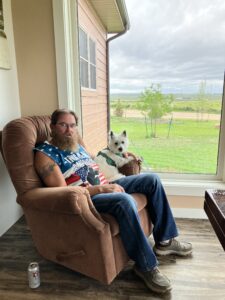
 My brother-in-law, Mike Reed doesn’t always spend his birthday with the guys, but when he does, he really does it up right. This year, doing it up right meant a brothers and brothers-in-law trip to Seward, Alaska to go fishing, and boy…did they go fishing!! The “gang” included Mike’s brothers, Tim and Shawn Reed; brothers-in-law, Mike Stevens and Kevin Forbis; as well as Mike’s nephew, Josh Reed (Shawn’s son). Their trip started with a drive from Casper, Wyoming to Denver, Colorado. After a short night in a hotel, the headed to a very busy Denver International Airport at 3:30 in the morning…finally arriving at their gate at 5:20am for a 6:00am flight to Seattle. Then it was on to Anchorage where they rented a car and drove to Seward and finally got to relax in their Airbnb.
My brother-in-law, Mike Reed doesn’t always spend his birthday with the guys, but when he does, he really does it up right. This year, doing it up right meant a brothers and brothers-in-law trip to Seward, Alaska to go fishing, and boy…did they go fishing!! The “gang” included Mike’s brothers, Tim and Shawn Reed; brothers-in-law, Mike Stevens and Kevin Forbis; as well as Mike’s nephew, Josh Reed (Shawn’s son). Their trip started with a drive from Casper, Wyoming to Denver, Colorado. After a short night in a hotel, the headed to a very busy Denver International Airport at 3:30 in the morning…finally arriving at their gate at 5:20am for a 6:00am flight to Seattle. Then it was on to Anchorage where they rented a car and drove to Seward and finally got to relax in their Airbnb.
Three days of fishing began the next morning with a great haul. The guys had a wonderful time talking and fishing, and it looks like everyone caught fish. There were some extra big fish, which is common in Alaskan waters, and I’m sure the guys loved them. Catching a big fish is always challenging and very cool. When you 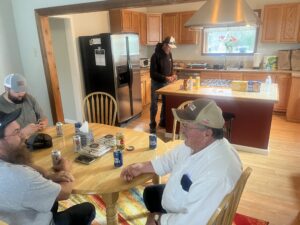
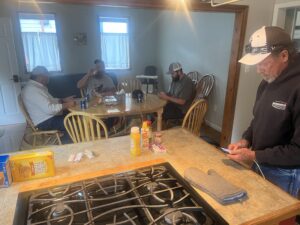 get them in the boat, you know that you have accomplished something. I’m not a fisherman, but I know a lot of people who find great satisfaction is fishing, and most of my brothers-in-law are among those people. So, Mike and the gang are out having a guys’ week, doing one of the things they really love…fishing.
get them in the boat, you know that you have accomplished something. I’m not a fisherman, but I know a lot of people who find great satisfaction is fishing, and most of my brothers-in-law are among those people. So, Mike and the gang are out having a guys’ week, doing one of the things they really love…fishing.
Mike works really hard. He and my sister, Caryl Reed own a ranch on the west side of Casper, where they grow oats, while they work their way into a good form of hay. They have a huge irrigation system, and Mike goes out there and wrestles that sprinkler system around to take good care of their crop. Crops like these can’t be left to chance. There is a specific way to grow these, and a process that leads up to producing hay. I did not know that, and quite possibly, Mike and Caryl didn’t either…but they are learning. Mike has purchased a tractor, and whatever else was needed to run their ranch successfully, and has embraced the process of being a rancher, 
 and we are quite proud of his progress. They don’t raise animals right now, but no one knows what the future might bring. Mike and Caryl are both retired now, so they can do anything they want to, including travel. For now, they are enjoying life to the fullest and for Mike, that means occasional hunting and fishing trips too. Today is Mike’s birthday. Happy birthday Mike!! I hope you and the guys are having a blast!! Have a great day!! We love you!!
and we are quite proud of his progress. They don’t raise animals right now, but no one knows what the future might bring. Mike and Caryl are both retired now, so they can do anything they want to, including travel. For now, they are enjoying life to the fullest and for Mike, that means occasional hunting and fishing trips too. Today is Mike’s birthday. Happy birthday Mike!! I hope you and the guys are having a blast!! Have a great day!! We love you!!
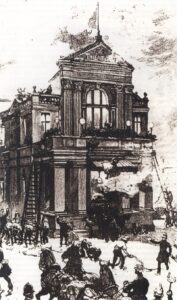 In American schools, and maybe in schools all over the world, children are used to the occasional fire drill, because it is a practice is designed to allow people to escape a fire, instead of losing their lives in a panic. Of course, this practice is fairly new, and came about after a number of fire disasters. One such disaster was the September 5, 1887, Exeter Theatre Royal fire in Exeter, England.
In American schools, and maybe in schools all over the world, children are used to the occasional fire drill, because it is a practice is designed to allow people to escape a fire, instead of losing their lives in a panic. Of course, this practice is fairly new, and came about after a number of fire disasters. One such disaster was the September 5, 1887, Exeter Theatre Royal fire in Exeter, England.
The fire broke out in the backstage area of the theatre during the production of “The Romany Rye” by George Robert Sims and produced by Wilson Barrett. When the fire was known, a panic ensued throughout the theatre. Whenever there is panic, someone is going to get hurt, or worse. In this case, 186 people died from a combination of the direct effects of smoke and flame, crushing and trampling, and trauma injuries from falling or jumping from the roof and balconies. It is such a sad situation, because if they had not panicked, it is likely that all or most of those would have survived. Of course, panic was not the only reason for the deaths, so we will never truly know if this could have been prevented. The Exeter Theatre Royal death toll makes it the worst theatre disaster, the worst single-building fire, and the third worst fire-related disaster in the history of the United Kingdom. Most of those who lost their lives were in the gallery of the theatre, which had only a single exit with several design flaws. The exit quickly became clogged with people trying to escape.
This was not the first time the Theatre Royal had been destroyed. The first Exeter Theatre Royal had been gutted by fire in 1885, and the new theatre was opened, on a new site, in 1886 to the design of well-known theatre architect CJ Phipps. The new theatre was leased exclusively to Sidney Herberte-Basing. The new 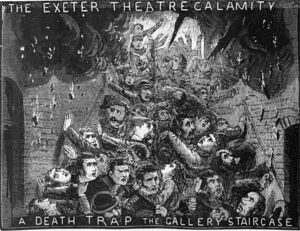 building was constructed from stone and red brick on the outside, but the inside was largely constructed of wood. Following the 1885 fire, the licensing authority of Exeter City Council ordered that the new theatre be constructed “in accordance with the rules and regulations of the Metropolitan Board of Works,” which was a statutory requirement in London under The Metropolitan Building Act 1855 (with theatre particulars added in the 1878 amendment), but not required in the regions. In his letter accompanying the plans to the Corporation Surveyor of Exeter City Council, Phipps directly states that the building met all the rules and requirements laid out, ans added that he had extensive experience in these types of construction. The letter stated, “…the theatre is designed in accordance with the rules and regulations of the Board of Works under the Act of 1878 and of the Lord Chamberlain – and having constructed some 40 theatres, I bring a somewhat large experience to bear on this subject.” – C.J. Phipps, Letter of 11 July 1885 from Phipps to the Corporation Surveyor of the City of Exeter.
building was constructed from stone and red brick on the outside, but the inside was largely constructed of wood. Following the 1885 fire, the licensing authority of Exeter City Council ordered that the new theatre be constructed “in accordance with the rules and regulations of the Metropolitan Board of Works,” which was a statutory requirement in London under The Metropolitan Building Act 1855 (with theatre particulars added in the 1878 amendment), but not required in the regions. In his letter accompanying the plans to the Corporation Surveyor of Exeter City Council, Phipps directly states that the building met all the rules and requirements laid out, ans added that he had extensive experience in these types of construction. The letter stated, “…the theatre is designed in accordance with the rules and regulations of the Board of Works under the Act of 1878 and of the Lord Chamberlain – and having constructed some 40 theatres, I bring a somewhat large experience to bear on this subject.” – C.J. Phipps, Letter of 11 July 1885 from Phipps to the Corporation Surveyor of the City of Exeter.
Nevertheless, during the licensing inspection, several deficiencies were noted and ordered to be corrected, including “installing an additional exit for the audience from the boxes, stalls, and pit, widening the exits to at  least 6 feet, changing some single leaf exit doors to double doors, and supplying 80 feet of hose for each hydrant (of which there were only two – one in the foyer and one in the “prompts” in front of the stage), rather than 40 feet which had been provided.” Unfortunately, there was no inspection of the stage, the mezzanine floor, or the fly galleries above the stage. There was only one exit with four right angled turns in it, from this area, and while two exits were called for, the idea was passed over because Phipps asserted “that a second exit was provided by climbing the railing at the front of the gallery and dropping to the second circle below.” That was, of course a crazy notion, that cost lives in the end. Apparently, this plan was accepted without further argument. In addition, there was to be an iron safety curtain, which was not fitted at the time of the fire, and a fire hydrant in the stage wings was on the plans of the theatre but never installed, despite Phipps being advised that the two hydrants installed were insufficient. In the end, the panic, along with the mishandled inspections and the improper plan design cost 186 people their lives.
least 6 feet, changing some single leaf exit doors to double doors, and supplying 80 feet of hose for each hydrant (of which there were only two – one in the foyer and one in the “prompts” in front of the stage), rather than 40 feet which had been provided.” Unfortunately, there was no inspection of the stage, the mezzanine floor, or the fly galleries above the stage. There was only one exit with four right angled turns in it, from this area, and while two exits were called for, the idea was passed over because Phipps asserted “that a second exit was provided by climbing the railing at the front of the gallery and dropping to the second circle below.” That was, of course a crazy notion, that cost lives in the end. Apparently, this plan was accepted without further argument. In addition, there was to be an iron safety curtain, which was not fitted at the time of the fire, and a fire hydrant in the stage wings was on the plans of the theatre but never installed, despite Phipps being advised that the two hydrants installed were insufficient. In the end, the panic, along with the mishandled inspections and the improper plan design cost 186 people their lives.
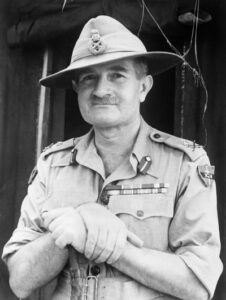
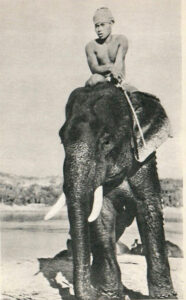 Most of us would never think of using an elephant in a battle, but James Howard Williams, also known as Elephant Bill, who was a British soldier and elephant expert in Burma thought about it. Born on November 15, 1897, at Saint Just, Cornwall, he was the son of a Cornish mining engineer, who had returned to Cornwall from South Africa, and his wife, a Welshwoman. Williams went to college at Queen’s College in Taunton, and following in his brother’s footsteps, studied at Camborne School of Mines. He then went on to serve as an officer in the Devonshire Regiment of the British Army in the Middle East during the First World War and in Afghanistan from 1919 to 1920. Williams served with the Camel Corps and as transport officer in charge of mules. The military was very different then, from what we know today. After his service was over, he decided to join the Bombay-Burmah Trading Corporation as a forester working with elephants to extract teak logs. Little did he know that this would be a life changing decision for him.
Most of us would never think of using an elephant in a battle, but James Howard Williams, also known as Elephant Bill, who was a British soldier and elephant expert in Burma thought about it. Born on November 15, 1897, at Saint Just, Cornwall, he was the son of a Cornish mining engineer, who had returned to Cornwall from South Africa, and his wife, a Welshwoman. Williams went to college at Queen’s College in Taunton, and following in his brother’s footsteps, studied at Camborne School of Mines. He then went on to serve as an officer in the Devonshire Regiment of the British Army in the Middle East during the First World War and in Afghanistan from 1919 to 1920. Williams served with the Camel Corps and as transport officer in charge of mules. The military was very different then, from what we know today. After his service was over, he decided to join the Bombay-Burmah Trading Corporation as a forester working with elephants to extract teak logs. Little did he know that this would be a life changing decision for him.
Williams learned so much about the elephants in Burma, that it was during that time he acquired his nickname, “Elephant Bill.” While his biggest calling was his work with the Fourteenth Army during the Burma Campaign of World War II, he was also known for his 1950 book Elephant Bill. He was made a Lieutenant-Colonel, mentioned in dispatches three times, and was awarded the OBE in 1945. His interest in elephants came after he read a book by Hawkes, called “The Diseases of the Camel and the Elephant” and decided on the postwar job in Burma. Initially he was at a camp on the banks of the Upper Chindwin River in Upper Burma. There, Williams was responsible for seventy elephants and their oozies (in Burma an oozie was an elephant trainer) in ten camps, in an area of about 400 square miles in the Myittha Valley, in the Indaung Forest Reserve. The camps were 6 to 7 miles apart. Between the camps were hills, three to four thousand feet high and filled with teak. To mill them, one tree was killed by ring-barking the base, and then felled. The three-year-old trees were mature and were now light enough to float. The logs were hauled by elephant (known as “sappers”) to a waterway, then floated down to Rangoon or Mandalay. The elephants were needed by the Royal Engineers for use in bridge building in places where heavy equipment could otherwise not be brought in, the Royal Indian Army Service Corps wanted them to be regarded simply as a branch of transport, but they also had great value in rescue. Elephants were so important to the harvesting process, that one elephant could be sold for $150,000, which is $2000 in American dollars. The elephants were as big a commodity as the teak wood. Believe it or not, teak was “as important a munition of war as steel,” so its extraction was an essential industry.
While elephants were most often used to extract the teak from the forests, they were used for another important extraction during World War II. When Japan entered the war, it was expected that they would be held in Malaya and Singapore. While many people were critical of them, the Bombay Burma Corporation arranged evacuation of European women and children, even though the government had no such plans. That evacuation took place in 1942, from February till the end of April. The retreat from Burma was to Assam via Imphal. The road to Assam went up the Chindwin to Kalewa, then up the Kabaw Valley to Tamu, and across five thousand-foot-mountains into Manipur and the Imphal Plain. During this time, Williams was attached to one evacuation party, which also included his wife and children. The Kabaw Valley was nicknamed “The Valley of Death” because of the hundreds of refugees who died there from exhaustion, starvation, cholera, dysentery, and smallpox. Nevertheless, while many people died along the way, many were also saved due to the elephant evacuation process. The well known “elephant whisperer” and his best beloved helpers waged guerrilla warfare and carried refugees to safety. They sometimes had to fight, possibly even while working to help the refugees to escape. He was a Burmese speaker with knowledge of Burma, including the Irrawaddy River area and jungle tracks, which gave him a distinct edge when it came to getting precious human cargo out of the danger zones.
Not all treatment of elephants during that time was humane, and many elephants that were captured by the Japanese, and later recaptured by Williams’ group and others like it, had to be “cured” after being attacked by Allied fighters when they were used in Japanese warfare, or treated for acid burns from wireless batteries carried on their backs in straw-lined boxes. I’m sure it was hard for the handlers to see their precious elephants 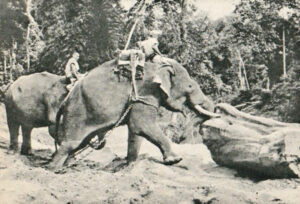
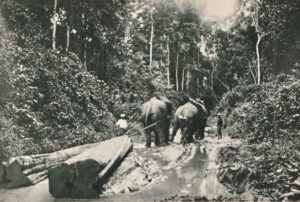 after such treatment. After World War II Williams retired to Saint Buryan, Cornwall, as an author and market gardener. He married Susan Margaret Rowland in 1932 after they met in Burma; they had a son, Treve and daughter, Lamorna while in Burma. After his death, on July 30, 1958, his wife Susan Williams wrote of her life with him in “The Footprints of Elephant Bill.”
after such treatment. After World War II Williams retired to Saint Buryan, Cornwall, as an author and market gardener. He married Susan Margaret Rowland in 1932 after they met in Burma; they had a son, Treve and daughter, Lamorna while in Burma. After his death, on July 30, 1958, his wife Susan Williams wrote of her life with him in “The Footprints of Elephant Bill.”

